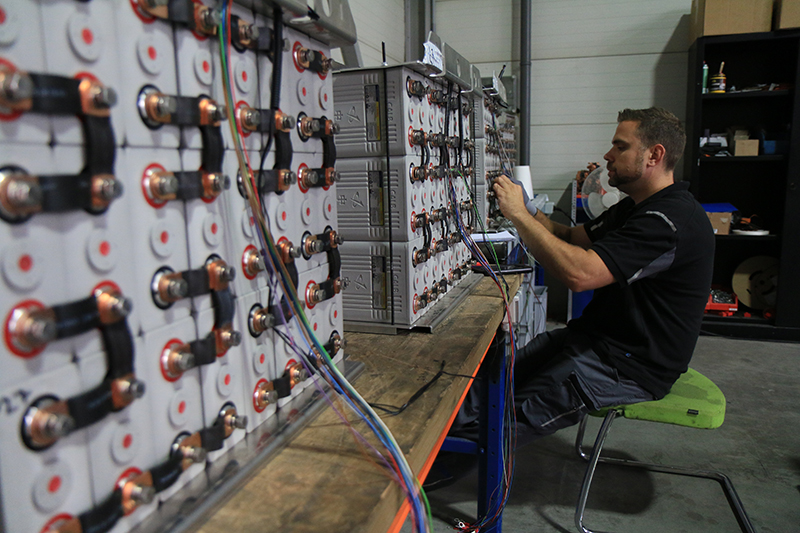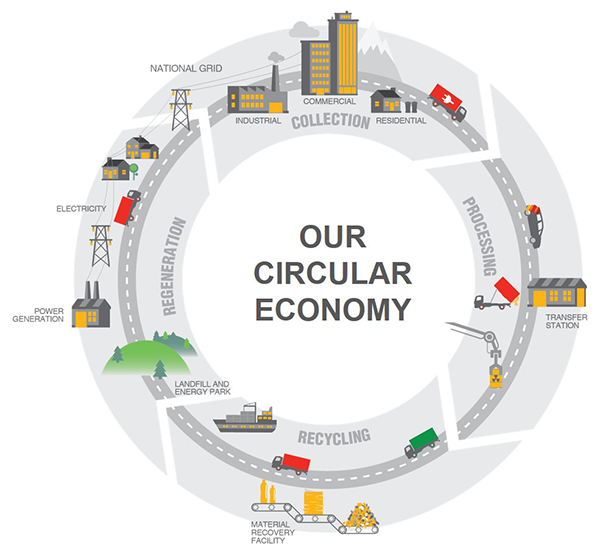Recently, Waste Management took delivery of a new truck. Not an unusual or exciting event in itself – in fact, last year we have averaged two new trucks a week – but, this truck is a little different. This is our first converted plug-in electric truck, just returned from Holland, where it has had its diesel engine removed and new electric motor installed in its place.
This truck is now on Auckland’s roads. It is a simple box body truck, but it will give us and our chosen conversion partners at Emoss in Holland some very valuable insights into managing an electric truck fleet in New Zealand. This is critical, because this box body – electric truck #001 – is just the start of our electric truck conversion program, which we announced last September alongside our commitment to our light fleet conversion.

Our new light fleet.
Since then, I have been amazed at the interest we have received from businesses and individuals who see the potential and benefit of electric vehicles. It has been fascinating to listen to the likes of Mercury, Air New Zealand and Westpac as they commit to convert to electric light vehicles. It has been great to see the government responding with support and information about electric vehicle ownership.
I have been convinced for some time that the rapidly evolving battery technology would drive a huge shift in the adoption of electric vehicles, particularly for many of us who travel such short distances most days. Many New Zealanders travel less than the average 30 km/day to and from work, meaning that the key hurdle for adoption of electric vehicles – range anxiety – shouldn’t be a barrier at all.
For our waste collection trucks, which travel around 140km per day, range anxiety was the least of our concerns. The stop-start nature of a waste collection truck, where the driver stops to pick up and empty a bin up to 1200 times per day, is actually a perfect use-case for electric rather than diesel power. Each time the truck stops, the braking creates regenerative energy that is transferred to boost the battery reserves.
This is in stark contrast to conventional fossil fuel powered vehicles where the energy loss in braking passes into the atmosphere as heat. If we were to convert our entire fleet of 800 trucks, we would save 100,000 litres of diesel a day. Not only a huge saving financially, but a massive improvement in our carbon footprint.

Building the battery packs.
Of course, the other advantage is that an electric vehicle has significantly fewer moving parts than a conventional diesel engine. We are now just starting to train our team with the skills necessary to maintain and support electric trucks, a process which will ramp up considerably as we start to receive our first waste collection vehicles this year. These will be the typical side-loader trucks that do residential curb-side waste collections, which form a significant portion of our fleet.
To support this change we are starting to upskill our teams to drive, maintain and manage electric vehicles. We are factoring in the necessary investment for our workshops. We are also looking at attracting new skills into the business. These additional factors will keep us at the forefront of electric vehicle technology in New Zealand and globally.
More broadly, our team within Waste Management have been energized (excuse the pun) throughout the project – which, of course, has been underway for some time. Finding the right partner for us was the first step. We needed a company with a proven track record in conversions which Emoss were able to provide. They have also understood our business and worked with our team to make sure we were able to take the lead in this space.
Taking the lead may not seem important from the outside, but we see being the first waste company in New Zealand with an electric truck program as a key opportunity to further enhance our commitment to the sustainability of our communities.
Electric vehicles build on our investment in modern sustainable landfills to manage New Zealand’s waste.
For more than a decade now we have been generating electricity from our landfill and energy parks – what we call modern, sustainable landfills. The technology we use to build, maintain and manage these facilities means that all waste is held in a fully sealed environment.
This enables us to capture the naturally emitted gas from the waste as it digests anaerobically. The gas is then fed into generators to create power. Our Redvale facility is Auckland’s largest renewable energy generator and generates enough electricity to power more than 12,000 homes.
We call this “a perfect circular economy”. Now, let’s make this perfect circular economy even more perfect. Let’s insert an electric waste collection truck into this process.

In one day, an electric waste collection truck stops around 1200 times, during which the truck collects 16 tonnes of waste. This waste is taken to Redvale, where it is safely contained and emits gas as it decomposes. Our network of pipes capture and extract the gas – we average a 95% capture rate – which in turn generates 6,000kWh of electricity through our onsite generators.
What do we do with this electricity? We power that one truck for one day so it can go and collect waste from another 1,200 homes, which will then create even more gas in our landfill, which we will then use to generate more electricity. Even better, each waste truck will generate enough electricity to power itself for one day – as well as 275 houses.
Of course, with more than enough electricity generated from the waste a truck collects to power itself, we envisage a time when the motor and battery technology advances to the point where our entire fleet could be powered by the waste we collect.
That’s why we see waste as a resource. Our challenge is to constantly look for the most efficient and effective way to do that. And we think having trucks “powered by waste” is exactly that.
I often say that sustainability is just “what we do”, it is our core purpose. I think that is why I have been surprised – pleasantly surprised – at the positive reaction to our electric vehicle program. For us, it is just part of being Waste Management and being in waste management. To do our job well, to play our role in a growing economy in a responsible manner, we are constantly looking for innovations that will make our communities and our business more sustainable into the future.
In doing this, we work alongside councils, businesses and government across New Zealand, understanding their waste reduction goals and working with them to achieve those goals. We invest in new technologies, research and innovation so we can provide the best possible advice with solutions that address all three parameters of social, economic and environmental sustainability.
At the same time, we continue to divert more than 150,000 tonnes of waste through recycling, and generate more than 60,000 tonnes of compost from food and green waste. And, when diversion is not possible, our modern landfill and energy parks use the remaining waste to generate electricity.
For electric vehicles, though, we are just at the tipping point. I believe that within five years, with businesses leading the way, the government providing their support and consumers demanding more sustainable solutions to meet their aspirations – from food to waste to transport – our one electric truck will become hundreds of electric trucks for many fleets across New Zealand.
We’re just pleased to be the first.




Leave a comment